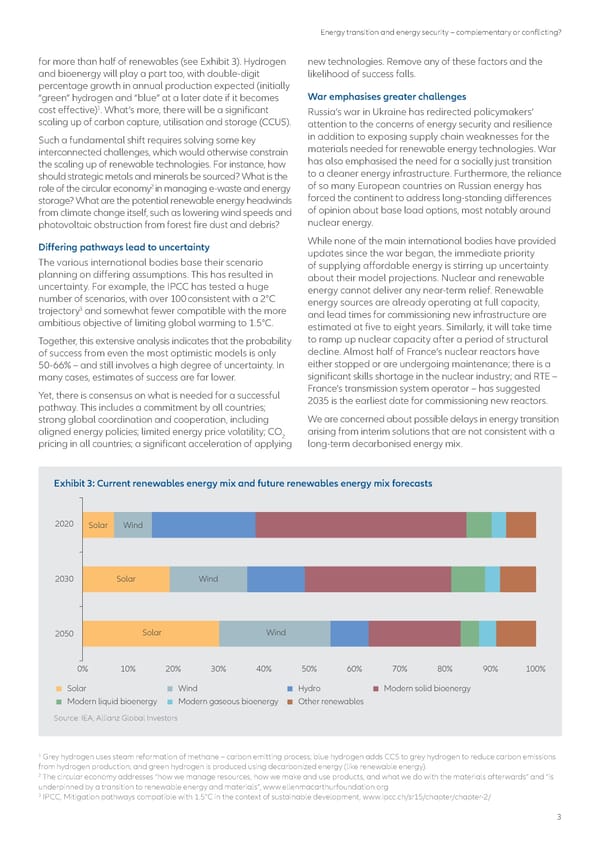Energy transition and energy security – complementary or conflicting? for more than half of renewables (see Exhibit 3). Hydrogen new technologies. Remove any of these factors and the and bioenergy will play a part too, with double-digit likelihood of success falls. percentage growth in annual production expected (initially “green” hydrogen and “blue” at a later date if it becomes War emphasises greater challenges 1 cost effective) . What’s more, there will be a significant Russia’s war in Ukraine has redirected policymakers’ scaling up of carbon capture, utilisation and storage (CCUS). attention to the concerns of energy security and resilience Such a fundamental shift requires solving some key in addition to exposing supply chain weaknesses for the interconnected challenges, which would otherwise constrain materials needed for renewable energy technologies. War the scaling up of renewable technologies. For instance, how has also emphasised the need for a socially just transition should strategic metals and minerals be sourced? What is the to a cleaner energy infrastructure. Furthermore, the reliance 2 of so many European countries on Russian energy has role of the circular economy in managing e-waste and energy storage? What are the potential renewable energy headwinds forced the continent to address long-standing differences from climate change itself, such as lowering wind speeds and of opinion about base load options, most notably around photovoltaic obstruction from forest fire dust and debris? nuclear energy. Differing pathways lead to uncertainty While none of the main international bodies have provided updates since the war began, the immediate priority The various international bodies base their scenario of supplying affordable energy is stirring up uncertainty planning on differing assumptions. This has resulted in about their model projections. Nuclear and renewable uncertainty. For example, the IPCC has tested a huge energy cannot deliver any near-term relief. Renewable number of scenarios, with over 100consistent with a 2°C energy sources are already operating at full capacity, 3 trajectory and somewhat fewer compatible with the more and lead times for commissioning new infrastructure are ambitious objective of limiting global warming to 1.5°C. estimated at five to eight years. Similarly, it will take time Together, this extensive analysis indicates that the probability to ramp up nuclear capacity after a period of structural of success from even the most optimistic models is only decline. Almost half of France’s nuclear reactors have 50-66% – and still involves a high degree of uncertainty. In either stopped or are undergoing maintenance; there is a many cases, estimates of success are far lower. significant skills shortage in the nuclear industry; and RTE – Yet, there is consensus on what is needed for a successful France’s transmission system operator – has suggested pathway. This includes a commitment by all countries; 2035 is the earliest date for commissioning new reactors. strong global coordination and cooperation, including We are concerned about possible delays in energy transition aligned energy policies; limited energy price volatility; CO arising from interim solutions that are not consistent with a 2 pricing in all countries; a significant acceleration of applying long-term decarbonised energy mix. Exhibit 3: Current renewables energy mix and future renewables energy mix forecasts 2020 Solar Wind 2030 Solar Wind 2050 Solar Wind 0% 10% 20% 30% 40% 50% 60% 70% 80% 90% 100% Solar Wind Hydro Modern solid bioenergy Modern liquid bioenergy Modern gaseous bioenergy Other renewables Source: IEA; Allianz Global Investors 1 Grey hydrogen uses steam reformation of methane – carbon emitting process; blue hydrogen adds CCS to grey hydrogen to reduce carbon emissions from hydrogen production; and green hydrogen is produced using decarbonized energy (like renewable energy). 2 The circular economy addresses “how we manage resources, how we make and use products, and what we do with the materials afterwards” and “is underpinned by a transition to renewable energy and materials”, www.ellenmacarthurfoundation.org 3 IPCC, Mitigation pathways compatible with 1.5°C in the context of sustainable development, www.ipcc.ch/sr15/chapter/chapter-2/ 3
 Energy transition and energy security – complementary or conflicting? Page 2 Page 4
Energy transition and energy security – complementary or conflicting? Page 2 Page 4